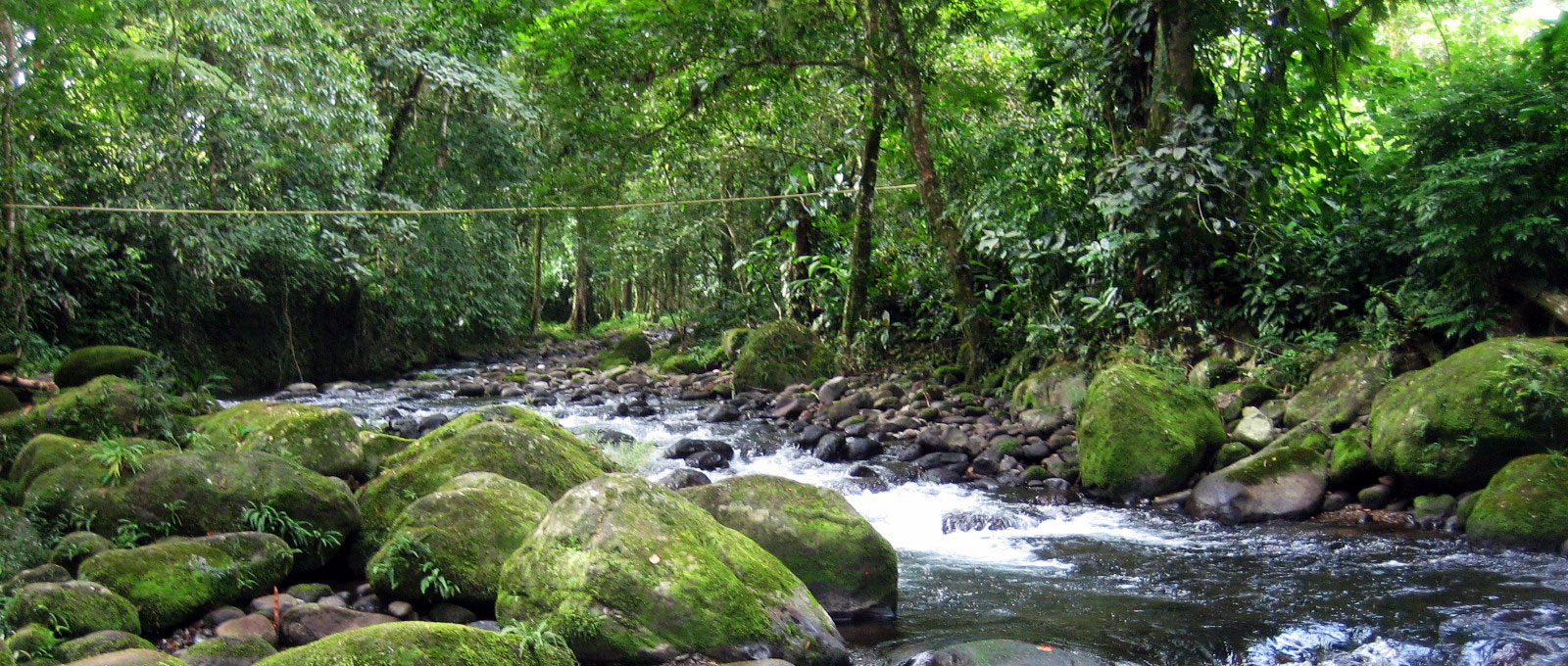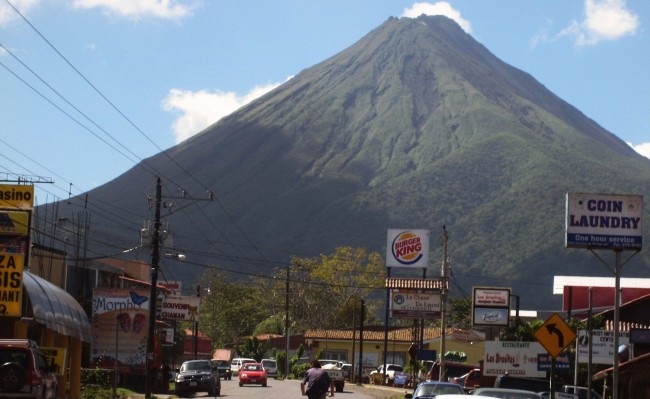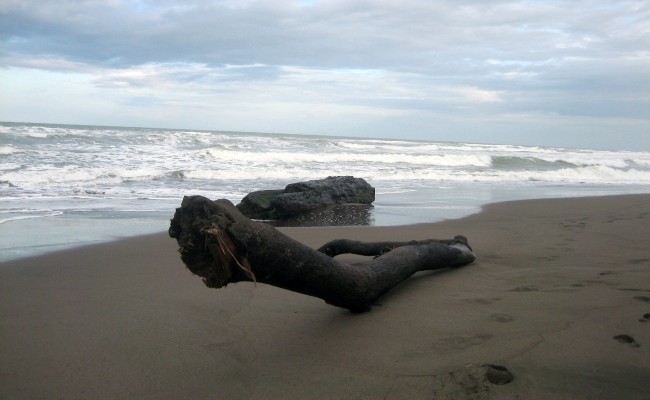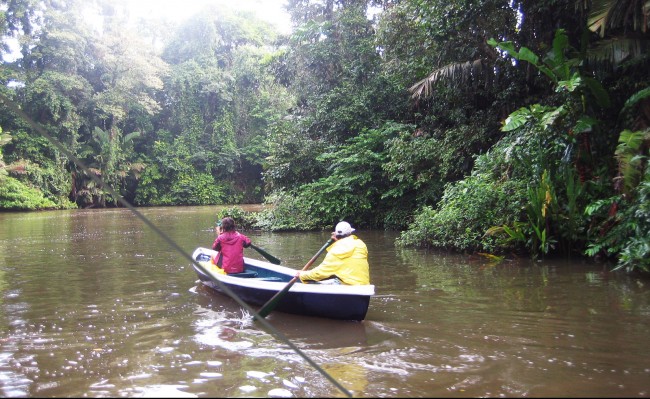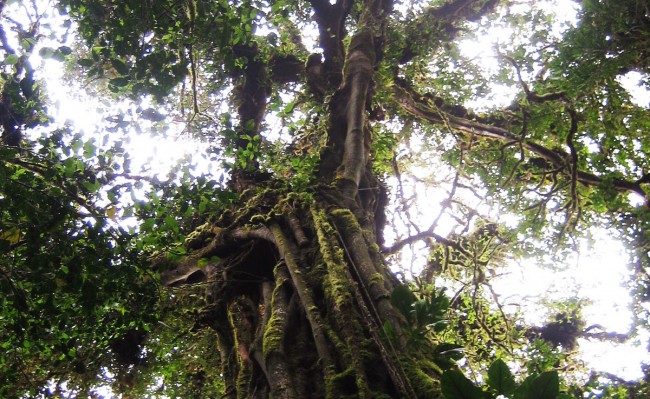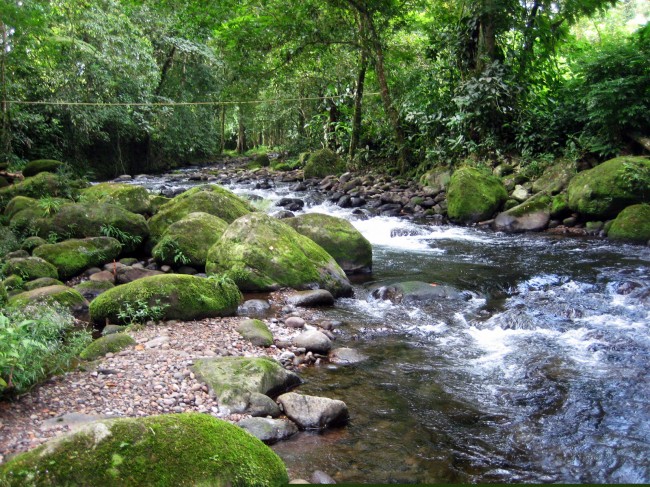My younger daughter was due to start a new job and wanted a vacation before getting down to work. I decided to join her, and we agreed on Costa Rica, which turned out to be a wise choice. In less than a week, Lauren and I visited an active volcano, rode a horse to a waterfall deep in a gorge, checked into a spa set in a jungle, walked in a cloud forest and enjoyed the spartan comforts of a lodge in a rainforest near the Caribbean Sea (although she would have loved for us to stay somewhere like the accommodation at Exceptional Villas.) It was a wonderful vacation, one that I would love to repeat in the not too distant future. Although, next time I would like to check out the Adventure Park and Hotel in Rincon de La Vieja, Guanacaste, Costa Rica.
Our journey began at Arenal Volcano National Park, one of several parks in Costa Rica whose centrepiece is an active volcano. The black wooden sign, embossed with bold yellow letters, proclaimed: “Zone of high volcanic risk. You enter under your own risk.” I was somewhat apprehensive as we blithely walked into the park. I love adventure travel, but I’m not reckless. When I spied that ominous sign, I flinched. Since we were part of a small group, led by an experienced guide, I went with the flow, if you can pardon the pun, hiking toward the western slope of Mt. Arenal, a peak 1,633 metres.
Mt. Arenal’s recent history is intimidating. Dormant for hundreds of years, it erupted in full fury on July 29, 1968. Massive explosions sundered its western half, leaving the cone intact but sending red-hot molten lava toward two sleepy villages in its path. Eighty people and 45,000 head of cattle were killed in a flash as lava inundated the villages and surrounding fields.
Since then, Mt. Arenal has been hissing menacingly, producing occasional ash clouds and spewing glowing lava, much to the delight and apprehension of intrepid tourists. In that spirit, I vicariously hoped that Mt. Arenal would put on a show for us. Not anything seriously dangerous, but enough to stir the adrenaline.
When I asked the guide for advice in case of a sudden eruption, he beamed, having been asked that question countlessly. “Run as fast as you can,” he replied with a grin. He quickly added that flight might be useless since the toxic fumes can kill in minutes. “Cover your face with a wet towel,” he advised. It seemed like irrelevant advice. Who had a wet towel anyway?
These disconcerting thoughts coursed through my mind as we passed an area of high reeds that had been a dense rainforest before the 1968 disaster. We soon found ourselves in an almost impenetrable jungle of high trees, vines, plants, brush and exposed rock that had been untouched by that monumental eruption.
We then reached a field of hard, irregular lava. A sign indicated that an eruption, in 1992, had created this lava. Climbing a series of ledges, we stopped at a natural viewing point. The top of Mt. Arenal was wreathed in clouds, while Lake Arenal loomed in the distance, rays of sunshine deflecting off its placid surface. The guide told us that, since the weather here is so changeable, picture-postcard views of Mt. Arenal are elusive. Much to our fortune, though, we soon heard the pop-pop sound of falling rock and saw puffs of smoke. Mt. Arenal was having a volcanic fit, albeit a minor one. My daughter and I were thrilled. Having come so far, we had been treated to a tremor of cosmic pyrotechnics.
The following day, sunny and warm, we went horseback riding on the eastern side of Mt. Arenal. The sun had burned away the mist and Mt. Arenal, covered with thick vegetation, was entirely visible. It was now benignly majestic, not in the least threatening. The horseback ride was scenic, taking us through patches of rainforest, past hills, pastures and farmsteads and over two shallow streams in a gully. We felt each and every bump as our horses trotted, sped up and galloped.
Before hiking to the base of the La Fortuna waterfall, we ascended a platform and admired its perfect symmetry. The 70 metre high, ribbon-like cataract was breathtaking as it cascaded down into a heavily wooded ravine. At the bottom, a few of the hikers donned swimsuits and plunged into the cool natural pools. Swimming directly under the waterfall is dangerous and is strictly forbidden.
We spent that evening at the five-star Tabacon Grand Spa and Thermal Resort, a short bus trip from our hotel in La Fortuna, a tourist-oriented town closest to Mt. Arenal. Indeed, Mt. Arenal is clearly visible from anywhere in La Fortuna. Tabacon, set in a lush rainforest that was devastated by the 1968 eruption, is like a Garden of Eden. Its manicured grounds are beautifully landscaped with a profusion of palm trees, decorative tropical plants and blazing flower beds. We enjoyed the pools and hot springs and sat under the mini waterfalls.
Nirvana.
Shrouded in mist and rain for usually nine months of the year, Costa Rica’s cloud forests are one of its greatest assets and draws. Selvatura Park, a reserve in Monteverde, contains one of the finest cloud forests in Central America. Cloud forests, found in mountainous terrain from Angola to Vietnam, are immersed in low clouds much of the time.
The journey to Monteverde took much longer due to the horrendous condition of the road, which, I assume, has not been paved to add to Monteverde’s allure as a remote and mystical destination. Whenever we hit a pothole, I wondered when the chassis would break. The scenery, consisting of folded green hills and pastures, was reminiscent of southern Europe.
Monteverde was a trackless, mostly uninhabited place until the early 1950s, when a group of peace-loving Quakers from Alabama settled here, eager to avoid the draft in the United States. Clearing brush and trees, they established dairy farms and a cheese factory. Their presence brought in squatters who had no regard for the integrity of the forest. The government thus created several reserves, touching off a boom in eco-tourism.
In Selvatura Park, one of these reserves, we joined a guided tour. Walking on a winding path made of concrete blocks firmly embedded in the soil, beneath a canopy of towering tropical hardwoods that inspired a sense of awe and wonder, we brushed past a tangled profusion of ferns and epiphytes (plants that live on other plants).
The climate was typically cool, even though Monteverde is near the Equator. Selvatura Park, straddling the Continental Divide, lies at an elevation from 140 metres to 1,120 metres above sea level. Travellers in Costa Rica typically wear warm-weather clothes, but in Monteverde, this is not advisable. Temperatures have been known to drop to 10 degrees celsius, which is downright cold by Central American standards. Occasionally, the sun broke through the mist, which blows in with the trade winds from the Pacific Ocean. If you prefer to tour the cloud forest in dry weather, try the late winter or early spring.
The cloud forest, a mossy, vine-choked retreat brimming with 450 varieties of orchids, has more than 100 species of mammals, from jaguars to sloths. Since they are active only at night and in the early morning, we did not see any of these elusive creatures. Fortunately, we spotted two birds, a brown owl and a Resplendent Quetzal, both perfectly camouflaged in the trees. If not for our guide, a hawk-eyed fellow with binoculars, we surely would have missed them.
He told us that the Resplendent Quetzal, one of the most beautiful winged birds on this planet, feeds on wild avocados. Not surprisingly, the tiny pits were strewn along the path. As we proceeded deeper into the reserve, we stopped to admire a splendid sight, a waterfall cascading into a stream.
The next day, at a facility close to Selvatura Park, we saw the cloud forest from a different vantage point, the Sky Walk. A series of six suspension bridges anchored on concrete platforms supported by iron beams and linked to trails, the Sky Walk enables visitors to see the forest from the height of the canopy. For especially a tree hugger, it is thrilling to walk above the canopy, free as a bird. We often paused to admire the canopy, a seamless blend of dense foliage, or to look down at the forest floor.
No roads lead to and from Tortuguero National Park, a pristine rainforest of infinite beauty off the coast of the Caribbean Sea. The park is so remote that there are only two ways of getting there, by boat or by plane. A jewel in the crown of Costa Rica’s gallery of natural wonders, it is the preserve of a range of creatures from monkeys, sloths and birds to snakes, caimans and turtles.
We reached Tortuguero in about six hours from San Jose, the capital. After a sometimes bumpy, bone-jarring ride, during which we passed banana and pineapple plantations, the bus pulled into a busy dock area adjacent to a wide canal leading to the sea. The boat we boarded was filled with mostly western tourists. The day was warm and sunny, and although we were there during Costa Rica’s dry season, there was no guarantee that we would not be drenched by a sudden storm.
Tortuguero is the wettest region of this small but geographically diverse country, and one should always be prepared for rain or drizzle. On this early afternoon in the third week of January, however, the sky was thankfully crystal clear.
Our destination, the Pachira Lodge, was about one hour away. As we set off, the greenish waters of the canal were calm and placid, reflecting sunlight and forest canopy on both sides of the canal. The weather remained fine as we penetrated the jungle.
Just minutes from the park, the Pachira Lodge is situated on 14 hectares in a lush rainforest. One of several lodges in the vicinity, it caters to intrepid travellers who appreciate nature but prefer not to rough it. The lodge draws an international clientele. We bumped into couples from Israel, Germany, Holland and the United States.
Its exquisitely manicured grounds are crisscrossed by a maze of pathways that end at the spacious dining room. The meals, though hardly of gourmet quality, are sufficiently tasty and filling, leaning heavily toward chicken, rice and black beans.
At night, as I drifted into sleep to the rhythm of a whirring overhead fan, I heard the hum of crickets and the eerie, disembodied cries of howler monkeys lurking in the dense bushes. The swimming pool, next to the bar, is shaped like a sea turtle. The veranda, off the dining hall, contains padded benches where you can wind down after a day of activities.
Boat tours are included in the package. The tour began shortly after sunrise, following a torrential downpour. It was still cloudy, and raindrops were falling intermittently. I wore a blue poncho I had purchased in the Amazon rainforest a few years ago. Lauren was enveloped in a yellow raincoat supplied by the captain. The rain turned hard as the boat picked up more people from a neighbouring lodge, but relented within five minutes as the sun finally appeared.
The rainforest was a tableau of magnificent hardwoods, palms, shrubs and mossy vines bathed in soft sunlight. The guide pointed to a pair of monkeys perched on a bough high in a tree. There are three species of monkeys here – howler, capuchin and spider. The howlers are the feisty noisemakers.
Birds are harder to spot, but their colourful plumages are worth the wait. A furry sloth, incredibly camouflaged, was sighted on a tree trunk. Sloths are amazingly indolent, rarely leaving the comfort and safety of their abodes. Amid a tangle of tree roots, a baby caiman was seen. It was absolutely motionless. If I had been able to stay longer, I would definitely have been tempted to book a place on a Costa Rica Focus bird watching tour as the birds here were fascinating.
Much of this coastal park of some 82,000 hectares extends into the sea. As we walked along the beach, the guide reminded us that bathing is strictly forbidden due to riptides and sharks. We gathered around him in a semi-circle and he talked about the once-endangered green sea turtles. From July until October, they converge on the beaches, laying their eggs in pits sufficiently far from the menacing waters.
The park, the habitat of leatherback, hawksbill and loggerhead turtles as well, was established in the 1970s to save the turtles and the rainforest from extinction. Until then, turtles were hunted and forests were logged to such an extent that both were threatened. Nowadays, local inhabitants depend on eco-tourism for a livelihood. Indeed, the sleepy and unremarkable village of Tortuguero – a short boat ride from Pachira Lodge – lives off the sale of handicrafts, souvenirs and T-shirts.
Canopy tours are popular, too. Until the 1980s, visitors who wanted to see the rainforest up close either had to walk or get into a boat. In canopy tours, which are optional at the Pachira Lodge, you view the jungle floor from high up. Climbing a ladder to a platform on a tree, I was carefully harnessed to a zip line. Placing one arm in front, on a handle, and another arm in the back to maintain balance, I was released on an exhilarating ride in which I magically glided above the treetops. It was a bit scary at first, but I readily got into the spirit of things as I zipped from one platform to the next, pretending to be Tarzan.
It was a carefree, radically different way of seeing the splendour of Costa Rica’s rainforest.
